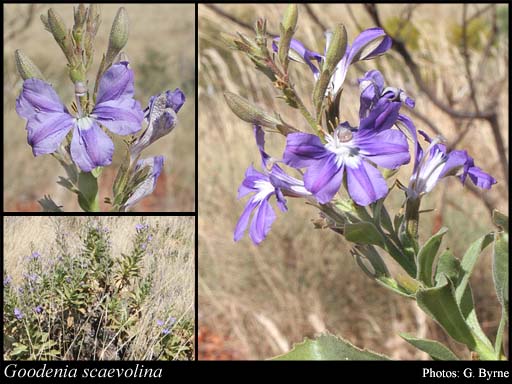- Reference
- Fragm. (Mueller) 1:118 (1859)
- Conservation Code
- Not threatened
- Naturalised Status
- Native to Western Australia
- Name Status
- Current
Erect, much-branched, viscid shrub, 0.3-1(-1.5) m high. Fl. blue/blue-purple/white, Feb to Aug or Oct. Shallow stony soils. Hill tops & slopes, sandstone outcrops.

Scientific Description
Stems unribbed. Leaves flat, 25-95 mm long, 15-30 mm wide, Indumentum absent (leaves glabrous); margins entire, toothed or lobed. Bracteoles present, 3.4-5.5 mm long, hairy, with glandular hairs. Pedicel pedicellate, Pedicel length the pedicels 2-4 mm long, Indumentum present, Hair type with glandular hairs. Calyx lobes present, Calyx length 3.5-7 mm long, hairy, with sparse, glandular hairs. Corolla blue, 15-19 mm long, without auricles, not spurred, hairy on the outside, with sparse, glandular hairs, hairy on the inside; central lobes 7.5-9 mm long, with wings; outer lobes 9-9.5 mm long, wings present on both sides, 0.8-1.3 mm wide. Anthers free. Ovary inferior, not gibbose; style 16-17 mm long, hairy; indusium single, hairy; ovules more than two. Flowers in February, March, April, May, June, July, August, September and October. Occurs in the Pilbara (PIL), Great Victoria Desert (GVD), Dampier land (DL), Ord-Victoria Plains (OVP), Tanami (TAN), Victoria Bonaparte (VB) and Central Kimberly (CK) IBRA Region(s), of the Northern (N) and Eremaean (E) Botanical Province.
Distribution
- IBRA Regions
- Central Kimberley, Dampierland, Great Sandy Desert, Little Sandy Desert, Ord Victoria Plain, Pilbara, Tanami, Victoria Bonaparte.
- IBRA Subregions
- Chichester, Fitzroy Trough, Fortescue, Hamersley, Hart, Keep, Mackay, McLarty, Mount Eliza, Pentecost, Pindanland, Purnululu, Roebourne, South Kimberley Interzone, Tanami Desert, Trainor.
- IMCRA Regions
- Canning.
- Local Government Areas (LGAs)
- Ashburton, Broome, Derby-West Kimberley, East Pilbara, Halls Creek, Port Hedland, Wyndham-East Kimberley.